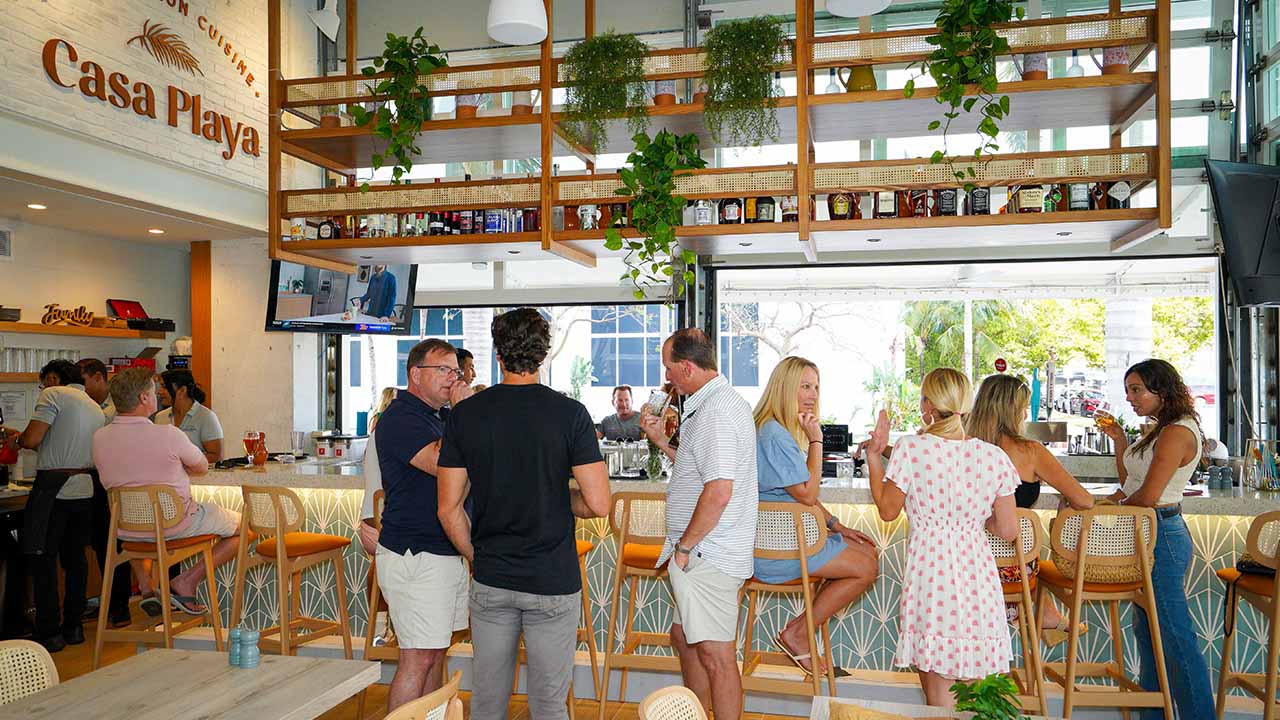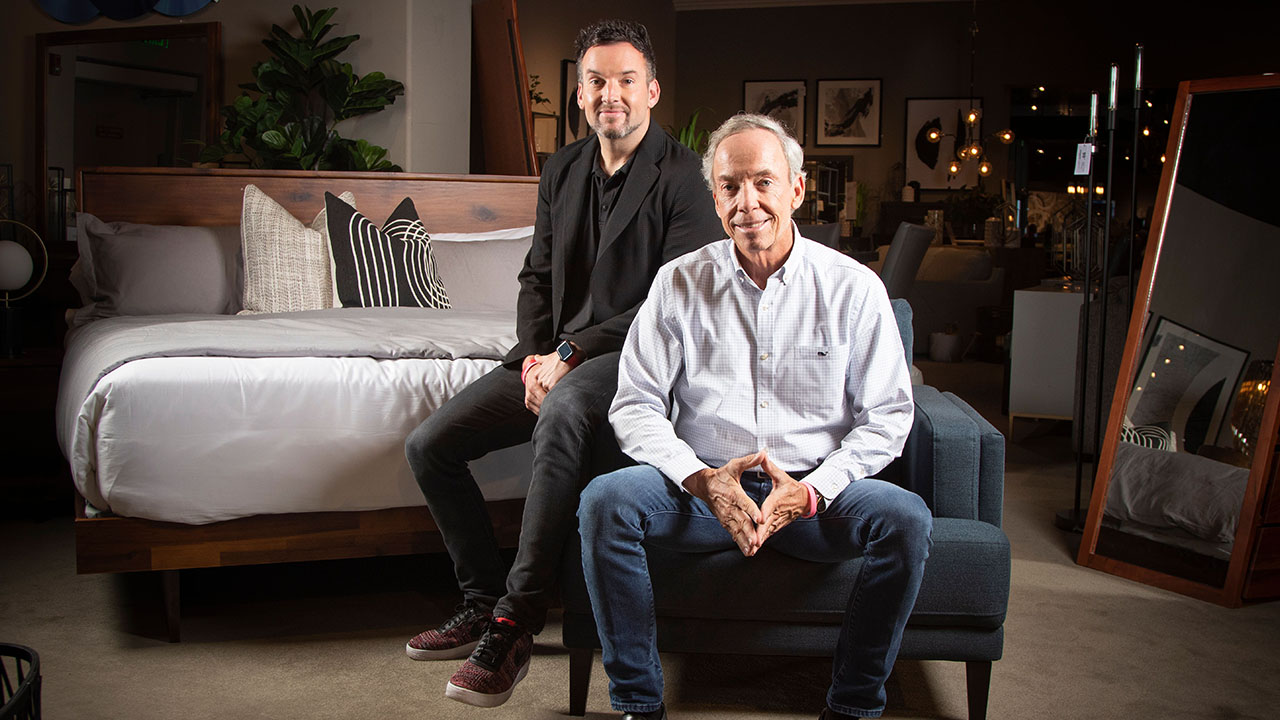Part 1 of 3
When you’re a big player dealing with other big players on the luxury scene, there’s a lot on the line. As president and COO of the developer Flag Luxury Group, Dayssi Olarte de Kanavos was right in the thick of things when the atmosphere started to change in South Beach, with the unveiling of a bold new kind of Ritz-Carlton in the rising-from-the-grave resort town. And she’s right in the thick of it again as the same oceanfront hotel reinvents itself a second time, courtesy of a high-profile merger with the smaller, more hipster Sagamore hotel next door.

It can’t be ignored that the brunette beauty, who grew up in Bogota and New York, is pretty high-profile herself, and has been for a long time. Not every hotel developer gets the New York magazine treatment with a portrait titled, “The Self-Made Socialite” (the Katherine Rosman-penned piece appeared in 2002). In it, the following signifiers are taken into account: the article’s elite setting of the Metropolitan Club for the Byzantine Ball (a benefit for Venice that she co-chaired); Dayssi’s dramatically late arrival in a satin gown; her expertly performed step-and-repeat; and the observation that “you need only look for a camera’s flash to locate her.” Not to mention the origins of her Town & Country cover photos and the Italian prince she dated before meeting and marrying developer Paul Kanavos.
Cut to two decades later, and it would be hard to square such a frivolous take being written about Dayssi Olarte de Kanavos today. Rosman mentions that Dayssi went to the renowned School of Hotel Administration at Cornell University and details its fraught sorority scene. But when one thinks of Dayssi and Cornell’s hotel school now, it’s because the hospitality training ground set her on a path to the C-suite. “In those days, anybody who was anybody in hospitality went to the hotel school at Cornell,” she says, which is not much of an overstatement. She served on the board for six years and her two older children are Cornell graduates. After Cornell, while studying real estate development and finance at NYU, her master’s degree thesis was prescient: Dayssi had to locate the city of tomorrow. She chose Miami. “Nobody would have believed it back then,” she says.
You can’t separate Dayssi’s résumé from the histories of 21st-century Miami Beach or that of the Ritz-Carlton company. In the 1990s, South Beach hadn’t yet been discovered by the masses, though gentrification was starting to happen subsequent to the successful historical preservation efforts of the 1970s and 1980s. The beach was the stomping ground for leggy models and their German photographers, Manhattan’s muscled and/or monied gay crowd, and Madonna and her nightclub owner pal, Ingrid Casares. It was edgy and sexy—and, because it attracted the world’s most beautiful people, exclusive—but it wasn’t luxury.
At the same time, the then-modern incarnation of the Ritz-Carlton brand was synonymous with a staid hotel in Boston. (The “Ritz-Carlton” name goes back to a New York City hotel that opened in 1911, and before that, to iconic Swiss hotelier César Ritz and his eponymous hotels in Paris and London. Today’s Ritz-Carlton Hotel Company was established in the 1980s.) The company’s eventual, stunning growth around the world—in both reputation and number and reach of properties—under president and COO Horst Schulze, his successor Simon Cooper, and the Ritz-Carlton’s Marriott parent company was unimaginable then.
At the time, the strength and value of a product like Ritz-Carlton was tied up in its consistency—some would say monotony—and what Dayssi calls an “old-fashioned, fuddy-duddy style.” That changed after 2000, when the hotel industry and the journalists who covered it began using terms such as “sense of place” and “relevant luxury.” Top resorts would now celebrate their settings at the expense of brand uniformity. The first indicator of that shift was The Ritz-Carlton, South Beach, which, by the time it emerged, would be unlike anything the brand had known before.
Built in 1951, the DiLido on Ocean Drive and Lincoln Road became the experiment. But first came the money matters—and hesitation. “My husband came from a development background in his family, with hotels in the United States and Europe,” Dayssi says. “His father redeveloped most of Boston—he actually developed some of the first Holiday Inns in the country and the first Marriotts. Bill Marriott was actually the general manager of his father’s hotel.” But Paul didn’t want to build hotels; too many horror stories passed down from his family, Dayssi remembers.
But Dayssi’s interest in hotels and an overture from Horst Schulze in the late 1990s changed that. “He was looking for strategic developers to bring the brand to the United States,” Dayssi says. So Flag Luxury first set to work on The Ritz-Carlton, Coconut Grove—a new build in the old style. “It was a huge milestone,” Dayssi recalls. “It was the first time that Ritz-Carlton branded residences in a hotel—it was super-successful, sold-out.”
Part 2 of 3
 The South Beach property, with its legacy and existing owner, was quite a different proposition. It had been in the Lowenstein family for several generations, Dayssi explains, “and Alfredo Lowenstein was doubtful that Paul could deliver Ritz-Carlton and find financing.” But Paul was persistent, and when he brought the brand and the funding, Lowenstein could barely believe it—he finally said, “For sure, I’m going to be your partner.” (Today, Lionstone Development, the Lowenstein family company, is helmed by CEO Diego Lowenstein, Alfredo’s son.)
The South Beach property, with its legacy and existing owner, was quite a different proposition. It had been in the Lowenstein family for several generations, Dayssi explains, “and Alfredo Lowenstein was doubtful that Paul could deliver Ritz-Carlton and find financing.” But Paul was persistent, and when he brought the brand and the funding, Lowenstein could barely believe it—he finally said, “For sure, I’m going to be your partner.” (Today, Lionstone Development, the Lowenstein family company, is helmed by CEO Diego Lowenstein, Alfredo’s son.)
The aesthetic conundrum—renovation or restoration?— was the subject of many an argument and negotiation. “It was being managed as a two-star, a Morris Lapidus-designed jewel but was really falling apart,” Dayssi recalls, “but the location was on the 50-yard line.” Just what the hotel would become was an open question, with the Lowensteins, Flag Luxury, Ritz-Carlton and the Miami Beach Historic Preservation Board often showing divergent agendas.
“The Ritz-Carlton wanted to keep the Queen Anne style,” Dayssi says. “We had different taste level. It didn’t make any sense. As a very young person, I was on the board of Save Venice, where we restored art and architecture. Historic preservation has always been a passion of mine. My interests really came into play here because we felt strongly that the hotel needed to be Miami Modern—the Morris Lapidus design. He designed furniture, plates, accessories. Paul and I had to visit Marriott three times to convince them that this was the appropriate thing to do.”
The preservation board mandated keeping the period terrazzo floor. “That was hard for Ritz-Carlton, with their penchant for marble,” Dayssi says. Lapidus’ curved lobby wall also made the cut—“This was quite shocking for the Ritz-Carlton people,” Dayssi says—though it was clad in cherry wood as a nod to the clubby brand. But there were far bigger aesthetic and conceptual issues to work out. The preservation board argued that Lapidus hadn’t intended for the DiLido to be a luxury hotel; it favored a more accessible approach.
For Paul and Dayssi Kanavos, that would not do. At the time, Dayssi was handling marketing, while Paul was taking charge of finance and development. “I didn’t run development like I do now,” she says. But she knew what the hotel should be. Dayssi’s taste level runs toward European icons of hospitality: the Hôtel Plaza Athénée in Paris and Switzerland’s Gstaad Palace. For their honeymoon, the couple had hotel-hopped among various Amanresorts properties in Southeast Asia not long after the launch of Bali’s groundbreaking Amankila. They didn’t take no for an answer.
“My husband and his brother actually tracked down Morris Lapidus personally and invited him to the Historic Preservation Board,” Dayssi says. The beloved architect—so identified with the midcentury style of Miami Beach—was in his 90s but vigorous, and he read the board the riot act in a succinct two sentences:
“Anything not luxury was imposed on me by the developer. This property was always meant to be luxury.”
Case closed.
The construction was not an easy road. The events of Sept. 11 intervened. “Our contractor lost his teams and he was going bankrupt and ended up using some of the funds from our property to fund other things,” Dayssi remembers. “It was a disaster. We sued, got money from the bonding company and were able to restart the project. It was like bringing an elephant over a hill. My husband is very tenacious—he made it happen, and we opened unofficially in December 2003.”
Acclaim followed. Though other “relevant luxury” properties flying the Ritz-Carlton flag had already debuted in California and Colorado—the Ritz-Carlton, Half Moon Bay opened in 2001, with the Bachelor Gulch location following in late 2002—the sweeping resort between Collins Avenue and the Atlantic was actually the first hotel of the new wave to gain the coveted approval of Bill Marriott. “Even to have wood floors in the restaurant instead of one of these awful multicolored carpets was a big deal,” Dayssi quips.
But The Ritz-Carlton, South Beach had something better than thick carpets and the signature Ritz-Carlton brass door handles. It had curves—in the design and on the glamorous pool deck, where oiled-up “tanning butlers” ministered to wide-eyed guests. (“That had legs forever—people loved the tanning butler,” Dayssi says. “The castings were especially popular among the management team. It could have been its own reality show.”)
And the hotel was a pioneer: The Ritz-Carlton has a robust VIP program—DiCaprio, Giselle, President Clinton—and though the hotel was forbidden to publicize their visits at the time, naturally, the buzz escaped. “It gave South Beach the stamp of approval for the rest of Americans who weren’t New Yorkers,” Dayssi says, candidly. “Then everyone else followed. “We opened at a time when there was a post-9/11 hole in the market—no development, no new hotels,” Dayssi says.
The hotel blew past projections within the first six months.
Part 3 of 3
 When asked if she and Paul had an I-told-you-so moment, Dayssi demurs: “We were happy to know we had influence with a really important brand and that they considered us a strategic developer that they could trust.”
When asked if she and Paul had an I-told-you-so moment, Dayssi demurs: “We were happy to know we had influence with a really important brand and that they considered us a strategic developer that they could trust.”
That trust is reaping dividends as Paul and Dayssi enter their next chapter with The Ritz-Carl ton, South Beach. (Flag Luxury is also building its fifth Ritz-Carlton, in New York.) From the earliest days of the partnership between the Lowensteins and Flag Luxury, the parties envisioned buying the Sagamore Hotel from owner Marty Taplin and integrating it into their resort. Handshake deals fell apart, and finally, when one stuck, Taplin fell—or jumped—from the balcony of his stepmother’s 25th-story Bal Harbour Towers apartment in 2016. For years, the dream was deferred.
But The Ritz-Carlton, South Beach and the Sagamore had remained friendly neighbors, with Dayssi eventually realizing that she and the Sagamore’s new owner, Ronny Ben-Josef of the Ben-Josef Group, had gone to the same high school but had lost touch. “We got together and it was such a great experience to think that these two kids from Forest Hills High School in Queens would end up owning these trophy properties right next door to each other in South Beach,” Dayssi says.
The Ben-Josefs started planning a much-needed renovation, and asked if the Ritz-Carlton would sell the Sagamore some air rights. But the rights issue proved complicated, COVID-19 happened, and Dayssi made a call to Ben-Josef, asking him to rethink his plan. “What could this be?” she asked him. “Could one plus one equal three? What would it be like if we turned the Sagamore into the Ritz-Carlton, and how would that add value to your property?” She reminded her old friend of the room rates the Sagamore could command with the Ritz-Carlton name behind it. Ben-Josef signed on.
The deal grew more ambitious as The Ritz-Carlton, Bal Harbour was added to the mix. When the smoke cleared, three families named Kanavos, Lowenstein and Ben-Josef had agreed to merge ownership of the three hotels, which together contain 600 rooms anchored by The Ritz-Carlton, South Beach and its $100 million renovation (completed in February 2020, just weeks before the pandemic shut it down; it has since reopened). “It’s going to be a spectacular campus and we’re really excited to do this,” Dayssi says. “And we’re really excited to work with the Ben-Josef family. They are a wonderful family with great values, just like the Lowenstein family. We love the Lowenstein family and their values. We all have a lot in common.” The unification of the two South Beach hotels is expected to take three years: 18 months of design and another 18 months of construction.
Just as Ritz-Carlton was protective of its identity two decades ago, the Sagamore has cultivated its own space as a premier art hotel—the place to be during Miami Beach’s annual Art Week. Would this marriage of brands experience growing pains reminiscent of 20 years ago? Dayssi says no. “One of the reasons we love the Sagamore is that Paul and I are collectors,” Dayssi enthuses. “The Lowenstein family are also collectors, and [Alfredo’s wife] Diana Lowenstein curated The Ritz-Carlton, South Beach’s collection; as a gallerist, she’s very passionate about art. We would never want to take away the Sagamore’s history and heritage.”
With Dayssi having helped to pave the way for Ritz-Carlton’s shift to “sense of place” 20 years ago, the road ahead—both for the Sagamore and the three-hotel merger—is likely to be smoother this time around. That’s a prime example of expertise and good taste buying you a wealth of opportunities.
















